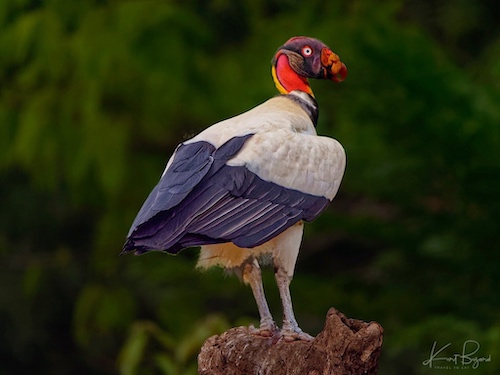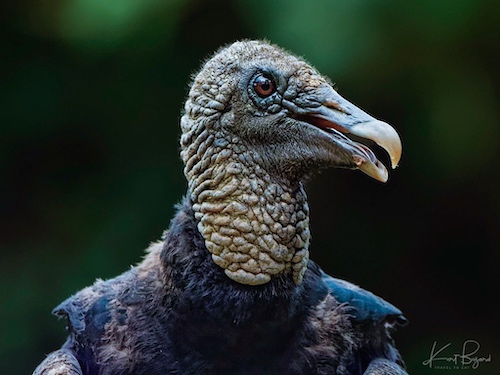
For those fortunate few who view a King Vulture (Sarcoramphus papa) for the first time, the experience will be unforgettable. King vultures are one of the largest New World vulture, second only to condors. It is not their size however that is visually arresting, but their bright white feathers with a vividly colored head. Certainly early native Americans would have immediately sensed the singularity of this majestic bird and would associate it with a god-like presence in their jungle world. In fact in Mayan legends, the bird was seen as a king who served as a messenger between humans and the gods. They would have observed its habit of displacing smaller vultures from a carcass and eating its fill while they wait, thus warranting the crown of a king among fellow birds. This bird was also known as the “white crow” by the Spanish in Paraguay. It was called cozcacuauhtli in Nahuatl, derived from cozcatl “collar” and cuauhtli “bird of prey”.
King Vulture




The King Vulture (Sarcoramphus papa) lives predominantly in tropical lowland forests stretching from southern Mexico to northern Argentina. The wings are short and quite broad and from the neck down the birds are white with a black band running along the rear edge of the wings. A small collar of feathers at the base of the neck is blackish-gray while the bare skin on the head and neck is orange, green, yellow and purplish blue. The crown is covered with small bristle-like feathers and a fleshy wattle directly above the nostrils. One of the most distinctive features of the adult is the brightly colored bare skin of the head and neck, which has intricate skin folds, vivid colors of reds, oranges, yellows, and purple, with a yellow or orange-red carbuncle at the base of the bill and a pink pendent crop. The iris is white, and the bill is orange red with a dark base. Though brightly colored, the vulture’s head and neck are bald. This may help the fastidious birds to stay clean, and ensure that bacteria-laden animal remains don’t fester in the bird’s plumage where they could spread disease. Its overall length ranges from 26–32 inches (67 to 81 cm) and its wingspan is 4–7 feet (1.2 to 2 m). Its weight ranges from 6–10 lb (2.7 to 4.5 kg).
Adolescent King Vultures




The King Vulture is minimally sexually dimorphic, with no difference in plumage and little in size between males and females. The juvenile vulture has a dark bill and eyes, and a downy, gray neck that soon begins to turn the orange of an adult. Younger vultures are a slate gray overall, and, while they look similar to the adult by the third year, they do not completely molt into adult plumage until they are around five or six years of age. Jack Eitniear of the Center for the Study of Tropical Birds in San Antonio, Texas reviewed the plumage of birds in captivity of various ages and found that ventral feathers (belly and chest) were the first to begin turning white from two years of age onwards, followed by wing feathers, until the full adult plumage was achieved. The final immature stages being a scattered black feathers in the otherwise white lesser wing coverts. On the head, the skin is wrinkled and folded, and there is a highly noticeable irregular golden crest attached on the cere above its orange and black bill. This caruncle or wattle does not fully form until the bird’s fourth year.
Black Vultures



Since there were quite a large number of Black Vultures (Coragyps atratus) in the same location, I thought I would add some photos for comparison. The range extends from the southeastern United States to Central Chile and Uruguay in South America. Although a common and widespread species, it has a somewhat more restricted distribution than its compatriot, the turkey vulture, which breeds well into Canada and south to Tierra del Fuego. The black vulture is a scavenger and feeds on carrion, but will also eat eggs or kill newborn animals. In areas populated by humans, it also feeds at garbage dumps. The black vulture is a fairly large bird of prey, measuring 22–29 inches (56–74 cm) in length, with a 52–66 inch (1.33–1.67 m) wingspan. Weight for black vultures from North America and the Andes ranges from 3.5 to 6.6 lb (1.6 to 3 kg) but in the smaller vultures of the tropical lowlands it is 2.6–4.3 lb (1.18–1.94 kg). The black vulture appears in a variety of Maya hieroglyphics in Mayan codices. It is normally connected with either death or as a bird of prey. The vulture’s glyph is often shown attacking humans. This species clearly lacks the religious connections that were seen in the King Vulture.


The Black Vulture soars high while searching for food, holding its wings horizontally when gliding. It flaps in short bursts which are followed by short periods of gliding. Its flight is less efficient than that of other vultures, as the wings are not as long, forming a smaller wing area. Like the turkey vulture, this vulture is often seen standing in a spread-winged stance. The stance is believed to serve multiple functions: drying the wings, warming the body, and baking off bacteria. This same behavior is displayed by other New World vultures, Old World vultures, and storks. On the spread wings, you can clearly see the white wingtips, which are the usual way these vultures are identified in flight.
Northern Crested Caracara



When we last saw the Crested Caracara on the Tárcoles River in Costa Rica, I mentioned the aggressive nature of this relative of falcons. While we were watching this group of much larger vultures, two Crested Caracara just flew in and began feeding. The Northern Caracara is a carnivorous scavenger that mainly feeds on carrion, but does occasionally eat fruit. The live prey they do catch is usually immobile, injured, incapacitated or young. Prey species can include small mammals, amphibians, reptiles, fish, crabs, insects, their larvae, earthworms, shellfish and young birds. In addition to hunting its own food on the ground, the northern caracara will steal from other birds, including vultures, buteos, pelicans, ibises and spoonbills. Because they stay low to the ground even when flying, they often beat vultures to carrion and can aggressively displace single vultures of most species from small carcasses. The Mexican ornithologist Rafael Martín del Campo proposed that the northern caracara was probably the sacred “eagle” depicted in several pre-Columbian Aztec codices as well as the Florentine Codex. This imagery was adopted as a national symbol of Mexico, and is seen on the flag among other places. Since the paintings at the time were interpreted as showing the golden eagle, it rather than the Crested Caracara, became the national bird.
Each of these birds has a surprising amount of history among Native Americans, they are after all imposing birds. As always I hope you enjoyed the post, comments or question are welcomed.

